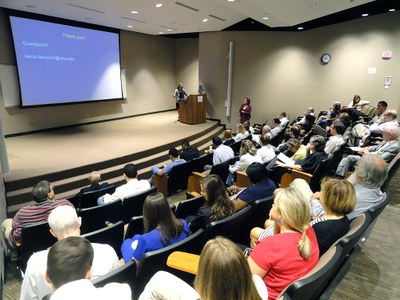A YEAR IN THE LIFE: MEDICAL SCHOOL CLASSES

BY GRANT MERCER – The first year of medical school is spent building a solid foundation of scientific knowledge, along with mastering basic clinical skills. Moving at a far faster pace than any undergraduate curriculum, medical school forces students to hone their study skills, time management abilities, and, of course, their memorization expertise. The first year can indeed be intimidating yet also quite exciting with its constant new experiences.
Here are the classroom experiences of the three first-year medical students Stethoscope Magazine is following during their first year.

Vanderbilt School of Medicine
EVAN MERCER – Vanderbilt School of Medicine divides its first year into five blocks. The first two blocks last for six weeks each, while the remaining three blocks last 12 weeks. Last semester the first two blocks – Human Blueprint Architecture and Microbiology/Immunology – were completed. This semester blocks on Homeostasis and anatomical units will be completed. While the schedule can differ from day-to-day, lecture/lab times are usually as follows:
Monday (8:00 – 12:00)
Tuesday (8:00 – 3:00)
Wednesday (8:00 – 12:00)
Thursday (8:00 – 5:00)
Friday (8:00 – 5:00)
For three days a week, the students begin with a Case-Based Learning (CBL) session, meeting in teams of eight to discuss two different cases relating to the material taught that week. On Mondays, the team is introduced to the case and then expected to do independent research related to the case. Then, for two hours each on Wednesday and Friday, the students work through the case as a team to make a diagnosis.

Vanderbilt Medical School Classroom
On Friday, the students discuss a non-medical topic, such as leadership or ethics, based on assigned articles that they read during the week. Additionally, on Fridays, there is a Physical Diagnosis class in which clinical skills are taught, such as using a stethoscope or performing a skin examination. There are afternoon activities on two of the weekdays (other than Friday) available to students. On Tuesday, Evan practices his Physical Diagnosis skills in the simulation lab, and on Thursday he shadows a Vanderbilt Hospital physician.
Evan felt that the material he learns in medical school is not necessarily harder than undergraduate course work, but the material comes so much faster that it can be difficult to absorb it all. Unlike undergraduate studies where there is usually a day between classes, medical school classes hit you with four hours of brand-new material every single day.
On average, Evan studies three to four hours a day. Evan noted that “given the quick pace of the classes, falling behind, for even a day, would be a bad idea, but the way in which the curriculum is laid out, the subject matter is constantly being reinforced.” The preparation required for his weekly CBL, weekly quizzes and essays, and constant group study sessions help Evan to stay on top of the material. Evan says that he “tries to reserve one weekend day without studying just to keep himself sane.” He recommended that while “medical school can be stressful, get to know your classmates during class and during your free time. Explore the city, try out new restaurants near campus, be active – essentially keep doing the activities you enjoyed as an undergraduate so you don’t burn out in med school.”

University of Louisville Medical School
ANDREW HEY – At the University of Louisville School of Medicine, Andrew is now working on a semester-long course – the Molecular Basis of Life, Defense, and Disease. Another two weeks of Biology Statistics will complete his first year. The course is broken down into five units, each one building upon the last. The first unit is heavy on the sciences – biochemistry, histology, pharmacology, and physiology. The role of blood and other body fluids is emphasized through the entire course. The remaining units are:
Unit 2 – Integrating red blood cell disorders with energy metabolism and nutrition
Unit 3 – Role of genetics, gene expression, cell cycles, and neoplasia
Unit 4 – Immunology’s role in inflammation and the overall immune system
Unit 5 – White blood cell disorders, hemostasis, and muscle physiology
Each unit ends with a non-cumulative exam. At the end of the 17-week course, a National Board of Medical Examiners (NBME) Cumulative Shelf Exam, a standardized test measuring competency levels in the basic and clinical sciences, is administered.
Andrew attends between four and seven classes every weekday. Class attendance is not mandatory and most students choose to stay home and watch the lectures online. Andrew, though, does attend his classes regularly so he can stay on top of all the material.

Louisville Medical School Classroom
Andrew found his undergraduate classes relatively easy, usually able to save his studying for the night before and still ace the exam. That changed in medical school. As he observed, “Everyone I know studies between four and six hours a day, and our class average is still around an 80%.” In addition, the course material taught in medical school is far more difficult and taught at a much faster pace. One of his professors compared it to “drinking out of a fire hose now instead of from a faucet as an undergraduate.”
The University of Louisville has a strict pass-fall grading policy. For every class in all four years, every student must earn at least a 70% on each of their exams as well as maintain an overall 70% average. Andrew recommends doing as many practice questions as possible. He found that professors like to take questions from practice exams and other study materials. Also practice questions help highlight what areas need a bit more attention. By identifying and focusing on these areas, it will ensure that staying in the “pass” column.
Andrew added that it is “important to take a break from studies every now and then. Find something that you are passionate about and do it a little every day. This will keep you happy and sane.” For Andrew, that passion is running and the outdoors. In fact, he runs three miles every day and goes camping about once a month. These keep him both “physically fit and happy, both of which are very important.”

Wake Forest School of Medicine
LEIGH ANNE KLINE – At Wake Forest School of Medicine, first-year students take one class at a time, broken down into blocks. Leigh Anne’s first three months were all about anatomy, broken down into four blocks – thorax, abdomen/pelvis, head and neck, and finally musculoskeletal. A multiple-choice exam was given at the end of each three-week block. Most of the lectures are not mandatory but are recorded for those who prefer to watch them online. A few of the lectures are required though. These classes are usually clinical application lectures and are “pretty fun” according to Leigh Anne. In addition to the regular lectures, small groups meet every other week to work on case-based applications and ethics scenarios.
Leigh Anne has noticed that some people study more than others, but everyone studies a great deal. Most of the students’ daily routines consist of going to class or watching the lectures online and then spending the rest of the day reviewing that material. “Some people say medical school is like a 9-5 job, but I honestly don’t think you’d be able to fit everything in if you only study 9-5.”

Wake Forest Medical School Classroom
Leigh Anne tends to study with a group. She noticed that “being around other people makes it seem less daunting. It can also really help you stay on track and motivated.” Another study tip from Leigh Anne was to review the Step 1 study materials as you go through the lectures as “it will really help with Step studying in the long run.” (note: The Step 1 exam is a required one-day standardized test, usually taken at the end of the second year.)
At Wake Forest, the grades in the pre-clinical years (about the first year and a half) are all pass/fail. Leigh Anne especially likes this system because “it fosters such a collaborative atmosphere at Wake Forest.” During the remaining years with their emphasis on clinical work, the grading scale changes to high pass, pass, low pass, and fail, giving those who work extra hard in clinical settings an opportunity to stand out.
NEXT UP: ATTENDING MEDICAL SCHOOL WITH A DISABILITY
